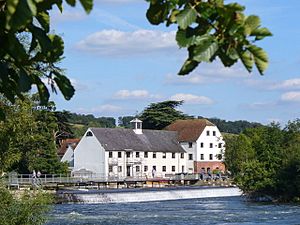Hambleden Mill facts for kids
Quick facts for kids Hambleden Mill |
|
|---|---|

Hambleden Mill and Weir
|
|
| Type | Watermill |
| Location | Hambleden |
| OS grid reference | SU 78447 85042 |
| Area | Buckinghamshire |
| Built | Late 18th century |
| Architectural style(s) | Georgian |
|
Listed Building – Grade II
|
|
| Official name: 1-10, Hambleden Mill | |
| Designated | 21 June 1955 |
| Reference no. | 1310707 |
| Designated | 22 January 1986 |
| Lua error in Module:Location_map at line 420: attempt to index field 'wikibase' (a nil value). | |
Hambleden Mill is a really old watermill located on the River Thames. You can find it at Mill End, which is close to the village of Hambleden in Buckinghamshire, England.
A cool footbridge connects the mill to Hambleden Lock, which is on the other side of the river in Berkshire. The mill building was given a special "Grade II listed" status in 1955. This means it's an important historic building. Today, it's no longer a working mill but has been turned into modern apartments. Right next to the mill is Hambleden Marina, which sits on two islands in the river. If you walk along the riverbank to the south-east, you'll find the spot where a Roman Villa used to be!
Contents
The Mill's Long History
Hambleden Mill has been around for a very long time! It was first mentioned in a famous old book called the Domesday Book in 1086. This book was like a big survey ordered by William the Conqueror to record everything in England. Back then, the mill belonged to Queen Matilda and earned 20 shillings a year. It also had a fishery that caught 1,000 eels every year!
Before the year 1235, the mill was given to Keynsham Abbey. A writer named Alison Uttley once called it "The most beautiful place in the whole length of the long Thames valley."
Building the Mill Over Time
The oldest part of the mill you see today was built in the late 1700s. It might even include parts of an even older mill from the 1600s. This older section is the tallest part of the building, with three main floors and an attic. It has a special roof style with sloped ends called "half-hipped gables." Later, in the 1800s, another part was added to the west, stretching along the river. This section has two stories and a slate roof.
From Flour to Flats
In the late 1800s, a barge (a type of flat-bottomed boat) called Maid of the Mill used to travel from Hambleden Mill every week. It carried flour to the Huntley & Palmers biscuit factory in Reading. On its way back, it brought broken biscuits that were sold cheaply to the local villagers.
The mill kept working until the 1950s. Around 1939, it was updated from using a traditional waterwheel and grinding stones to a water-turbine that powered steel rollers. By the early 1970s, the mill stopped working. In 1974, permission was given to turn it into apartments. During these big changes, the outside of the mill was covered in white wooden boards, and many of its old windows were replaced.
Right next to the mill, away from the river, is Mill House. This house is also a Grade II listed building. It was built around 1770 for the mill owner. It has walls made of flint stone and a front that was covered and painted white.
Exploring the Area Around the Mill
The mill is next to a series of weirs that stretch across the River Thames. Weirs are like small dams that raise the water level upstream. This created the fast flow of water needed for the old watermill. It also helps keep the river deep enough for boats.
Locks and Footbridges
The weirs run diagonally across the river to Hambleden Lock. A lock is like a water elevator that helps boats move between different water levels. The lock is on the western side of the river in Berkshire.
A footbridge follows the line of the weir all the way across the Thames. This means you can walk from the path next to Hambleden Mill to the Thames riverside path on the Berkshire side. It's a popular spot for visitors and artists, and you can find many old postcards showing the mill, weir, and lock.
Islands and Roman History
The two Hambleden Mill Islands are in the river right next to the mill. The mill-stream, which used to guide water to the water-wheel, created one of these islands. This island, along with another nearby, is now used by Hambleden Marina for mooring (parking) boats.
To the south-east of the marina, there's a very old Roman Villa site. It was first noticed in 1921 during a dry summer when outlines of walls appeared in the grass. In the hot summer of 1975, even more details of the villa's walls and other buildings became visible. This allowed experts to map out the site, including possible wharves (docks) along the river. This important historical site was given legal protection in 1979. It's thought that this villa might have been connected to another Roman villa nearby called Yewdon Villa.
Protecting the Area: Conservation Status
Hambleden Mill is located within a special area called the Mill End, Hambleden Conservation Area. This area was first set aside for protection in 1982. A conservation area is a place that has special historical or architectural importance, and rules are put in place to protect its unique character.
This conservation area includes both the small village of Mill End and the land around Yewden Manor. It's also part of the Chiltern Hills Area of Outstanding Natural Beauty. This means the area has beautiful landscapes that are protected for everyone to enjoy.

